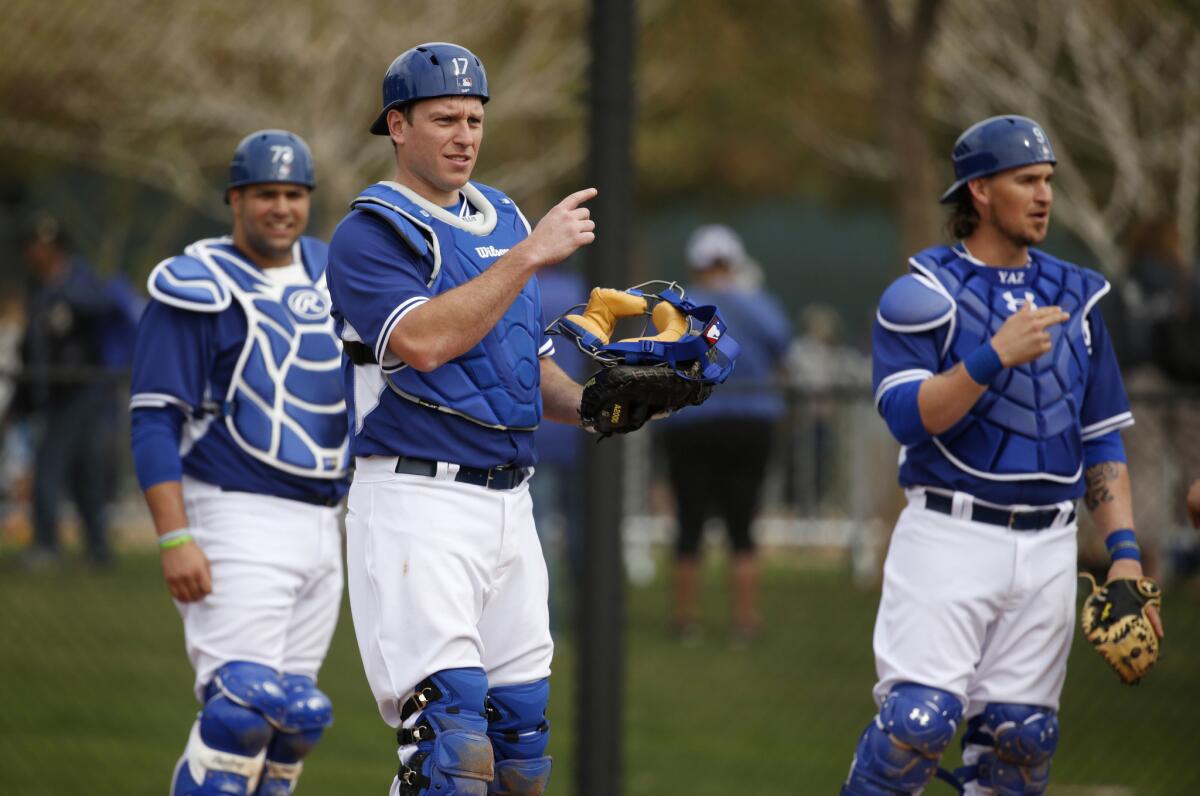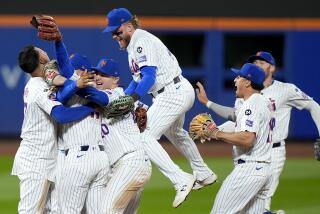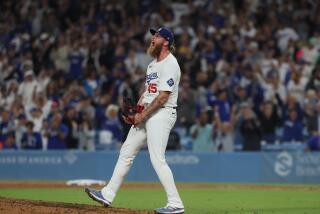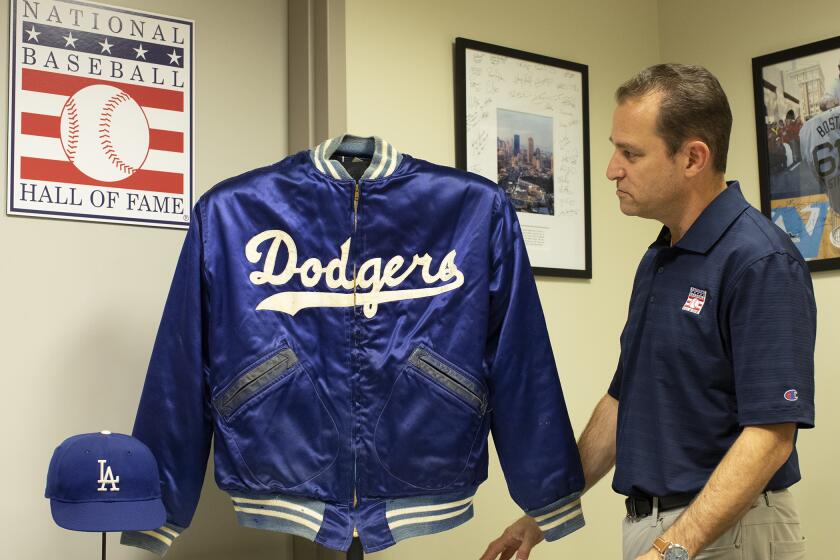Dodgers catchers Yasmani Grandal, A.J. Ellis apply received wisdom

- Share via
Reporting from SCOTTSDALE, Ariz. — Over the last three years, Yasmani Grandal has been called everything from a potential All-Star to a drug cheat.
Now, with the Dodgers about to break camp, the 26-year-old catcher is embracing a new identity: servant.
“You are a servant to your pitchers,” Grandal explained.
To become the catcher the Dodgers envisioned when they acquired him as part of the trade that sent Matt Kemp to the San Diego Padres, Grandal believes he will have to live by this philosophy, which was introduced to him by A.J. Ellis.
While Grandal is expected to replace Ellis as the team’s primary backstop, his compatibility with the pitching staff is one of the several factors Manager Don Mattingly will have to consider when determining how to divide playing time between them.
The Dodgers’ everyday catcher for the three previous seasons, Ellis is perhaps best known for developing strong relationships with his pitchers, in particular three-time Cy Young Award winner Clayton Kershaw. When Ellis’ place on the team was in question this off-season, it was Kershaw who most vocally championed his return.
Grandal, on the other hand, was notoriously unpopular among some Padres pitchers and didn’t catch on days when Andrew Cashner, Tyson Ross or Ian Kennedy started.
While Grandal said he was proud of his partnerships with the pitchers he caught — among them Odrisamer Despaigne — he acknowledged he viewed what happened as an incentive to change.
“Last year was a big eye opener, a learning experience for me, kind of learning how to interact a little better with the guys,” Grandal said.
The process of reinventing himself started when he played winter ball in the Dominican Republic.
“I think the one thing that helped me a lot was going into winter ball and having a brand-new pitching staff, guys that I never caught before and starting that interaction with them,” he said.
Grandal continued to do that in the Dodgers’ clubhouse this spring, impressing Ellis in the process.
“I’ve been blown away by his work ethic,” Ellis said.
Starting pitcher Brandon McCarthy, who hadn’t previously thrown to either Grandal or Ellis, said he viewed the two catchers similarly.
“I like them both,” McCarthy said. “In terms of game calling, I think they’re definitely thinking along with me. They’re seeing exactly what I need to do to be successful.”
Much like how Grandal is attempting to learn from Ellis on how to manage a pitching staff, Ellis is trying to pick up Grandal’s pitch-framing techniques — the subtle art of turning borderline pitches into called strikes.
Advanced metrics indicate that Grandal is one of the baseball’s best pitch framers and Ellis one of the worst.
Ellis said he is working in particular on how he receives balls that are low in the strike zone.
“That seems to be the area where I’ve lost some pitches, based on what the numbers tell us,” Ellis said. “I’m trying to maybe catch farther out in front of me, when in the past maybe I was catching the ball a little deeper. Maybe I can catch it before it leaves the zone.”
Ellis won’t know how much he has improved until he starts playing in regular-season games, for which pitch-tracking technology is used.
“You’re hopeful,” Ellis said.
Ellis also is optimistic he will be a better receiver and thrower than he was last year, when he never regained his footing after an early-season knee operation.
Ellis threw out 25% of potential base stealers last season, down from 44% in 2013 and 33% in 2012.
Ellis has thrown out three of six during the exhibition season.
“Health-wise, it’s the best I’ve felt before my season in 2012,” Ellis said. “It’s as strong as I’ve felt, which is a great thing.”
Grandal’s problems behind the plate were more severe than Ellis’.
The genesis of Grandal’s issues date to a career-altering 2013 season. He was suspended for the first 50 games because of his links to a Florida clinic that distributed performance-enhancing drugs to professional athletes, including Alex Rodriguez. He was reinstated in late May, only for his season to last a little more than a month. In early July he underwent a season-ending knee operation.
Grandal rushed back to be ready for the start of last season. In retrospect, he said, he tried to do too much too soon. He caught only 76 games but his 12 passed balls were the most in the majors. He threw out only 13% of potential base stealers, down from 23% in his rookie season in 2012.
“Throwing the ball is 10 times better,” Grandal said.
Eight of 14 stolen-base attempts against Grandal this spring have failed.
Though Grandal and Ellis aren’t hitting particularly well — Grandal is batting .216, Ellis .176 — they think their stronger lower bodies will also result in improved offensive production.
The batter’s box is where the switch-hitting Grandal is believed to have a sizable advantage over the right-handed-hitting Ellis.
Grandal has a higher career walk rate and on-base percentage than Ellis, whose best virtue as a hitter is his patience.
Grandal also has considerably more power. As a rookie, he hit eight home runs in 192 at-bats. Last season he hit 15 home runs, all while batting from the left side, in 377 at-bats.
“I know the numbers don’t show, but I think my spring training has been hitting line drives right at guys,” he said. “All those line drives end up turning into base hits once the season starts.
“For me, it’s been a great spring. I’ve been able to work on a lot of little things I wanted to work on to become a better hitter, a better catcher.”
[email protected]
Twitter: @dylanohernandez
More to Read
Are you a true-blue fan?
Get our Dodgers Dugout newsletter for insights, news and much more.
You may occasionally receive promotional content from the Los Angeles Times.










